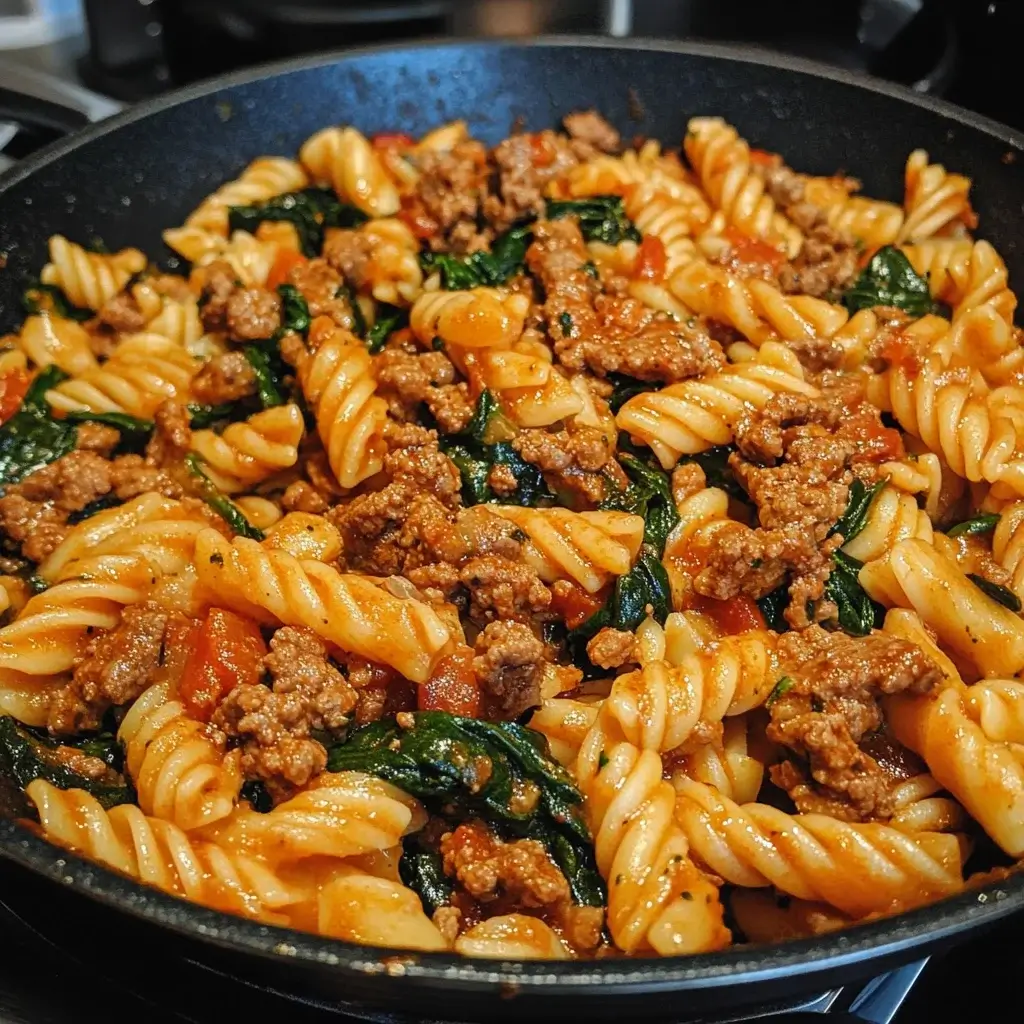Weeknights in our house can be a whirlwind. Between school pickups, after-school activities, and just the general chaos of family life, finding time to cook a healthy and delicious meal often feels like a Herculean task. That’s where this Beef and Spinach Pasta Skillet recipe has become an absolute lifesaver. Honestly, I stumbled upon it during a frantic search for something quick, satisfying, and, most importantly, something the kids would actually eat without a battle. Let me tell you, this recipe delivered on all fronts and then some! The beauty of it lies in its simplicity – everything cooks in one skillet, minimizing cleanup (major win!), and the combination of savory beef, tender pasta, and vibrant spinach is surprisingly delicious and wholesome. Even my pickiest eater, who usually eyes anything green with suspicion, happily devoured his portion. The rich tomato-based sauce coats everything beautifully, and the slight hint of garlic and Italian herbs elevates it from a basic pasta dish to something truly comforting and flavorful. If you’re looking for a weeknight meal that’s fast, fuss-free, and family-approved, you absolutely have to try this Beef and Spinach Pasta Skillet. It’s become a regular in our rotation, and I have a feeling it will become one in yours too!
Ingredients
- Ground Beef: Provides a hearty protein base for the skillet, choose lean ground beef to reduce fat content.
- Pasta: Short pasta shapes like penne, rotini, or shells work best as they cook evenly in the skillet and hold the sauce well.
- Spinach: Fresh spinach adds a boost of nutrients and vibrant color. Baby spinach is convenient and tender.
- Onion: Forms the aromatic base of the sauce, adding savory depth.
- Garlic: Essential for flavor, garlic enhances the overall taste profile of the dish.
- Canned Diced Tomatoes: Creates the flavorful and slightly tangy sauce base. Use diced tomatoes with their juices for moisture.
- Tomato Paste: Concentrates the tomato flavor and adds richness to the sauce.
- Beef Broth: Provides liquid for cooking the pasta and adds savory depth to the sauce. Low sodium broth is recommended to control salt content.
- Italian Seasoning: A blend of herbs that adds classic Italian flavor to the dish.
- Salt: Enhances the flavors of all ingredients. Season to taste.
- Black Pepper: Adds a touch of spice and complements the other flavors. Season to taste.
- Olive Oil: Used for sautéing the vegetables and browning the beef. Use extra virgin olive oil for best flavor.
- Parmesan Cheese (Optional): For serving, adds a salty and cheesy finish.
Instructions
- Prepare the Vegetables: Start by chopping the onion and mincing the garlic. Set them aside. If using large spinach leaves, roughly chop them. Baby spinach can be used as is.
- Brown the Beef: Heat olive oil in a large skillet over medium-high heat. Add the ground beef and cook, breaking it apart with a spoon, until it is browned and no longer pink. Drain off any excess grease from the skillet.
- Sauté Aromatics: Add the chopped onion to the skillet with the browned beef. Cook for about 3-5 minutes, until the onion becomes softened and translucent.
- Add Garlic and Tomato Paste: Stir in the minced garlic and tomato paste to the skillet. Cook for about 1 minute, stirring constantly, until fragrant. This step helps to bloom the tomato paste and enhance its flavor.
- Build the Sauce: Pour in the canned diced tomatoes (undrained) and beef broth into the skillet. Stir to combine all the ingredients, scraping up any browned bits from the bottom of the skillet.
- Season and Simmer: Add the Italian seasoning, salt, and black pepper to the sauce. Bring the mixture to a simmer.
- Add Pasta: Stir in the uncooked pasta to the simmering sauce. Make sure the pasta is mostly submerged in the liquid. If needed, add a little more beef broth or water to ensure the pasta cooks properly.
- Cook Pasta and Reduce Sauce: Reduce the heat to medium-low, cover the skillet, and simmer for the time indicated on your pasta package directions, or until the pasta is cooked through and tender. Stir occasionally to prevent the pasta from sticking to the bottom of the skillet and to ensure even cooking. As the pasta cooks, the sauce will thicken.
- Stir in Spinach: Once the pasta is cooked al dente, remove the lid from the skillet. Stir in the fresh spinach. Cook for another 1-2 minutes, or until the spinach wilts and becomes tender.
- Check Seasoning and Serve: Taste the pasta skillet and adjust seasoning with salt and pepper as needed. Serve hot, optionally garnished with grated Parmesan cheese.
Nutrition Facts (Approximate)
- Serving Size: 1.5 cups
- Calories per Serving: 450 kcal (Approximate, may vary based on specific ingredients and portion size)
- Protein: 30g
- Fat: 15g
- Saturated Fat: 6g
(Please note: Nutritional information is an estimate and may vary based on specific ingredients used and portion sizes. For accurate nutritional information, use a nutrition calculator and input the specific brands and quantities of ingredients used.)
Preparation Time
- Prep Time: 15 minutes (Chopping vegetables, measuring ingredients)
- Cook Time: 25 minutes (Browning beef, simmering sauce, cooking pasta)
- Total Time: 40 minutes (From start to finish, a quick and easy weeknight meal!)
How to Serve
- Classic Parmesan: Serve hot bowls of Beef and Spinach Pasta Skillet topped with freshly grated Parmesan cheese for a traditional Italian touch.
- Crusty Bread: Pair with a side of warm, crusty bread or garlic bread for soaking up the delicious sauce.
- Side Salad: A simple green salad with a light vinaigrette provides a refreshing contrast to the richness of the pasta skillet.
- Roasted Vegetables: Serve alongside roasted vegetables like broccoli, asparagus, or bell peppers for added nutrients and flavor.
- Red Pepper Flakes: For those who like a little heat, offer a sprinkle of red pepper flakes on the side.
- Fresh Herbs: Garnish with fresh herbs like chopped parsley or basil for added freshness and visual appeal.
Additional Tips for the Best Beef and Spinach Pasta Skillet
Choose Lean Beef
When preparing a Beef and Spinach Pasta Skillet, selecting lean ground beef is essential for creating a dish that is both delicious and healthier. Lean ground beef typically contains less fat, which not only reduces the overall calorie content but also minimizes the greasy texture that can dominate the dish. Opt for ground beef labeled as 90% lean or higher, which ensures a good balance between flavor and healthiness. If you do choose to use regular ground beef, which may have a higher fat content, make sure to thoroughly drain off the excess fat after browning. To do this effectively, you can use a colander or tilt the skillet to allow the fat to pool to one side, using a spoon to remove it. This simple step helps maintain a more balanced flavor in your pasta dish and prevents it from becoming overly oily.
Don’t Overcook the Pasta
Cooking the pasta correctly is crucial for achieving the perfect texture in your Beef and Spinach Pasta Skillet. Aim for an al dente finish, which means the pasta should be firm to the bite but not hard. This cooking method allows the pasta to absorb some of the sauce’s flavors without becoming mushy. Remember, the pasta will continue to cook once it’s added to the skillet, so it’s better to undercook it slightly (about 1-2 minutes less than the package instructions suggest). This extra care ensures that your pasta maintains its shape and provides a delightful contrast to the tenderness of the beef and spinach.
Add Spinach at the End
Spinach is a wonderful addition to any pasta dish, but timing is key when adding it to the skillet. To preserve its vibrant green color and essential nutrients, introduce the spinach towards the end of the cooking process. Once your beef and sauce mixture is nearly complete, stir in the fresh spinach and allow it to wilt gently for just a minute or two. This not only maintains the spinach’s bright appearance but also ensures that it retains its nutritional value, providing a rich source of vitamins A, C, and K, along with iron and fiber. The result is a dish that looks appealing and is packed with healthy ingredients.
Customize with Vegetables
One of the best aspects of a pasta skillet is its versatility. Don’t hesitate to customize your dish by adding a variety of vegetables. Sliced bell peppers, mushrooms, zucchini, or carrots can be sautéed alongside the onions for extra depth of flavor and nutrition. Bell peppers add a sweet crunch, mushrooms bring an earthy umami flavor, while zucchini and carrots introduce a subtle sweetness and texture. By incorporating these vegetables, you not only enhance the visual appeal of your dish but also boost its fiber content and overall health benefits, making it a more well-rounded meal.
Spice it Up
For those who enjoy a little heat, there are several ways to elevate the flavor profile of your Beef and Spinach Pasta Skillet. A pinch of red pepper flakes can add a nice kick without overwhelming the other ingredients, or you might opt for a dash of hot sauce stirred directly into the sauce. For an even bolder option, consider swapping out the ground beef for spicy Italian sausage. This substitution infuses the dish with robust flavors from the herbs and spices typically found in Italian sausage, enhancing the overall taste experience. Adjust the spice level to suit your palate, whether you prefer a mild dish or something that has a bit more fire.
Cheese Lovers Rejoice
Cheese can transform your pasta skillet from good to exceptional, adding creaminess and depth to the dish. Incorporating shredded mozzarella, provolone, or a blend of Italian cheeses directly into the skillet enhances the dish’s flavor and texture. As the cheese melts, it creates a gooey, comforting layer that envelops the beef and pasta. For an even more decadent experience, consider topping your skillet with additional cheese before placing it under the broiler for a few minutes. This will create a beautiful golden crust, further elevating your dish and making it irresistible to cheese enthusiasts.
Make it Ahead
Meal prepping can save you time during busy weekdays, and the Beef and Spinach Pasta Skillet is perfect for this purpose. You can prepare the entire dish as directed but slightly undercook the pasta to ensure it doesn’t become mushy upon reheating. Once prepared, store the skillet in an airtight container in the refrigerator for up to three days. When you’re ready to enjoy it, gently reheat on the stovetop or in the microwave, adding a splash of broth or water if needed to loosen the sauce. This makes it a convenient option for those who want a wholesome meal ready to go with minimal effort.
Freezer-Friendly for Meal Prep
In addition to being a great make-ahead meal, the Beef and Spinach Pasta Skillet is also freezer-friendly, making it an excellent choice for meal prep enthusiasts. Allow the dish to cool completely before transferring it to freezer-safe containers or resealable bags. It can be stored in the freezer for up to 2-3 months. When you’re ready to enjoy a comforting meal, simply thaw the skillet in the refrigerator overnight. For the best results, reheat it thoroughly on the stovetop or in the microwave, adding a bit of broth or water if the sauce has thickened. This method not only saves time but also ensures that you have a wholesome, home-cooked meal available whenever you need it.
FAQ – Frequently Asked Questions About Beef and Spinach Pasta Skillet
Q1: Can I use different types of pasta?
A: Absolutely! While short pasta shapes like penne, rotini, and shells are recommended, you can use other pasta types like farfalle (bow-tie), fusilli, or even elbow macaroni. Just be mindful of the cooking time, as different pasta shapes may cook at slightly different rates. Adjust the cooking time as needed to ensure the pasta is cooked al dente.
Q2: I don’t have beef broth, can I use something else?
A: Yes, you can substitute beef broth with chicken broth, vegetable broth, or even water in a pinch. However, beef broth will provide the richest and most savory flavor that complements the beef. If using water, you might want to add a bouillon cube or a teaspoon of beef base to enhance the flavor.
Q3: Can I use frozen spinach instead of fresh?
A: Yes, frozen spinach is a convenient alternative to fresh spinach. If using frozen spinach, be sure to thaw it completely and squeeze out as much excess water as possible before adding it to the skillet. You will typically need about half the amount of frozen spinach compared to fresh spinach. Add the frozen spinach at the same time you would add fresh spinach, towards the end of the cooking process.
Q4: How can I make this recipe vegetarian?
A: To make this recipe vegetarian, simply omit the ground beef. To add heartiness, you can add a can of drained and rinsed cannellini beans or chickpeas along with the diced tomatoes. You can also increase the vegetables, adding more mushrooms, zucchini, or bell peppers. Use vegetable broth instead of beef broth.
Q5: Is this recipe spicy?
A: As written, this recipe is not spicy. It has a mild and savory flavor profile from the Italian seasoning and garlic. However, you can easily add spice by incorporating red pepper flakes, a pinch of cayenne pepper, or a dash of hot sauce to the sauce. You can also use spicy Italian sausage instead of ground beef for a spicier version.
Q6: How do I prevent the pasta from sticking to the bottom of the skillet?
A: To prevent pasta from sticking, ensure there is enough liquid in the skillet so the pasta is mostly submerged. Stir the pasta skillet occasionally during cooking, especially in the beginning, to distribute the pasta and prevent sticking. Using a non-stick skillet also helps.
Q7: Can I add cheese to the sauce while cooking?
A: Yes, you can definitely add cheese directly to the sauce! Stir in shredded mozzarella, provolone, or an Italian cheese blend towards the end of cooking, along with the spinach. Cover the skillet for a minute or two to allow the cheese to melt and become gooey. This will create a richer and cheesier pasta skillet.
Q8: How long does leftover Beef and Spinach Pasta Skillet last?
A: Leftover Beef and Spinach Pasta Skillet can be stored in an airtight container in the refrigerator for up to 3-4 days. Ensure it is cooled completely before refrigerating. Reheat thoroughly on the stovetop or in the microwave until heated through. You may need to add a splash of broth or water when reheating to loosen the sauce, as pasta tends to absorb liquid as it sits.






